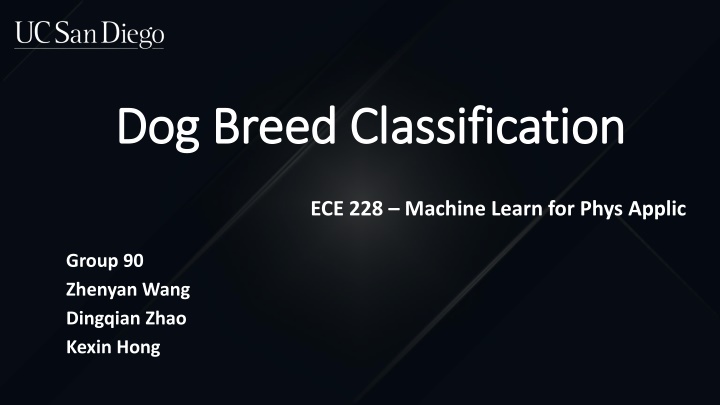
In-Depth Dog Breed Classification Using Machine Learning
Explore the world of dog breed classification through a comprehensive study utilizing machine learning techniques. From literature review to model implementation, this project delves into feature extraction, dataset preprocessing, and model evaluation using popular CNN architectures like VGG16, Inception, and Xception. Follow the journey to unravel the breeds of dogs in images and enhance your understanding of visual categorization experiments.
Download Presentation

Please find below an Image/Link to download the presentation.
The content on the website is provided AS IS for your information and personal use only. It may not be sold, licensed, or shared on other websites without obtaining consent from the author. If you encounter any issues during the download, it is possible that the publisher has removed the file from their server.
You are allowed to download the files provided on this website for personal or commercial use, subject to the condition that they are used lawfully. All files are the property of their respective owners.
The content on the website is provided AS IS for your information and personal use only. It may not be sold, licensed, or shared on other websites without obtaining consent from the author.
E N D
Presentation Transcript
Dog Breed Classification Dog Breed Classification ECE 228 Machine Learn for Phys Applic Group 90 Zhenyan Wang Dingqian Zhao Kexin Hong
CONTECTS Background introduction Literature review Data preprocess Model Results and future work
Background Determine the breed of dogs in an image Interesting for potential dog owners An excellent domain for visual categorization experiments
Literature review Conventionally, CV problems have been solved using HOG, SURF, etc. Recently, features extraction task has been mostly shifted toward CNN since the success of AlexNet[1] and VGG[2]. After that, deeper models such as GoogleNet, ResNet[3] and DenseNet[4] are introduced. For fine-grained categorization, some relies on segmentation.[5] Another work uses multiple kernel framework.[6] Besides that, there are a variety of technics and models including Inception, Xception, SVM-based regressor, ResNet, etc.[7-8]
Data Preprocess Dataset from Stanford dog dataset 120 types of total 10223 pics Use 2247 pics of 20 types for quicker experiment, reshape into Split into 80% training and 20% validation Reshape into 299*299 for convenience Images from dataset
Feature extraction Transfer learning from pretrained networks: Neural Networks pretrained on Imagenet extract different level features Feature may include the structures of a dog image Add fully connected layers after pretrained model, classify breeds of dogs
Model Used Feature extractors: VGG16, Inception, Xception
Model Used Feature extractors: Inception Breeds of dogs
Model Used Feature extractors: Xception
Model Used Classifier: Logistic Regression Classifier
Results Model 1: VGG16 + Logistic regression
Results Model 2: Inception + Logistic regression
Results Model 1: Xception + Logistic regression
Future Work Apply traditional ML classifier like support vector machine. Don t use pre-trained model as feature extractor but append one or two fully- connected layers and fine-tune it.
Reference [1] A. Krizhevsky, I. Sutskever, and G. E. Hinton, ImageNet Classification with Deep Convolutional Neural Networks, Adv. Neural Inf. Process. Syst., pp. 19, 2012. [2] K. Chatfield, K. Simonyan, A. Vedaldi, and A. Zisserman, Return of the Devil in the Details: Delving Deep into Convolutional Nets, arXiv Prepr. arXiv , pp. 111, 2014. [3] K. He, X. Zhang, S. Ren, and J. Sun, Deep Residual Learning for Image Recognition, Arxiv.Org, vol. 7, no. 3, pp. 171180, 2015. [4] C. Szegedy et al., Going deeper with convolutions, Proc. IEEE Comput. Soc. Conf. Comput. Vis. Pattern Recognit., vol. 0712June, pp. 19, 2015. [5]Belhumeur, P.N., Chen, D., Feiner, S.K., Jacobs, D.W., Kress, W.J., Ling, H., Lopez, I., Ramamoorthi, R., Sheorey, S., White, S., Zhang, L.: Searching the World s Herbaria: A System for Visual Identification of Plant Species. In: Forsyth, D., Torr, P., Zisserman, A. (eds.) ECCV 2008, Part IV. LNCS, vol. 5305, pp. 116 129. Springer, Heidelberg (2008)
Reference [6]Nilsback, M.E., Zisserman, A.: Automated flower classification over a large number of classes. In: Proc. 6th Indian Conf. on Computer Vision, Graphics and Image Processing, pp. 722 729 (2008) [7]Kaitlyn Mulligan1 and Pablo Rivas. Dog Breed Identification with a Neural Network over Learned Representations from The Xception CNN Architecture, Int'l Conf. Artificial Intelligence (2019) [8]Jiongxin Liu1, Angjoo Kanazawa2, David Jacobs2, and Peter Belhumeur1 Dog Breed Classification Using Part Localization [9] https://neurohive.io/en/popular-networks/vgg16/ [10] https://cloud.google.com/tpu/docs/inception-v3-advanced#introduction [11] https://www.quora.com/When-should-we-use-logistic-regression-and-Neural-Network
Thanks Watching
